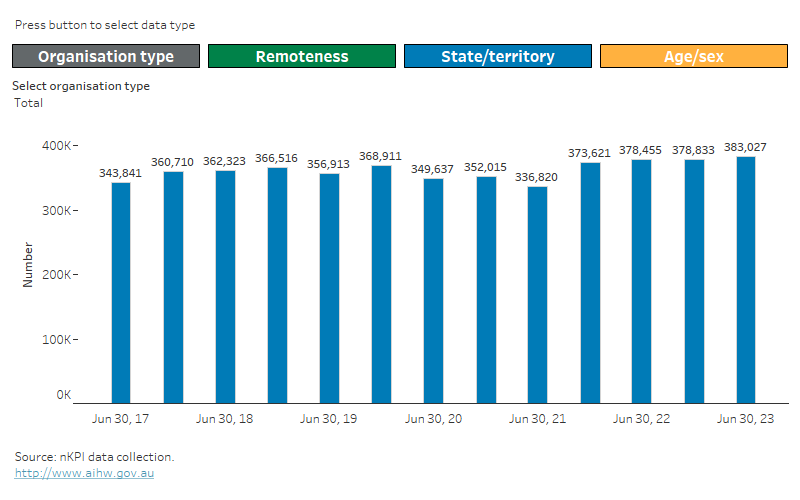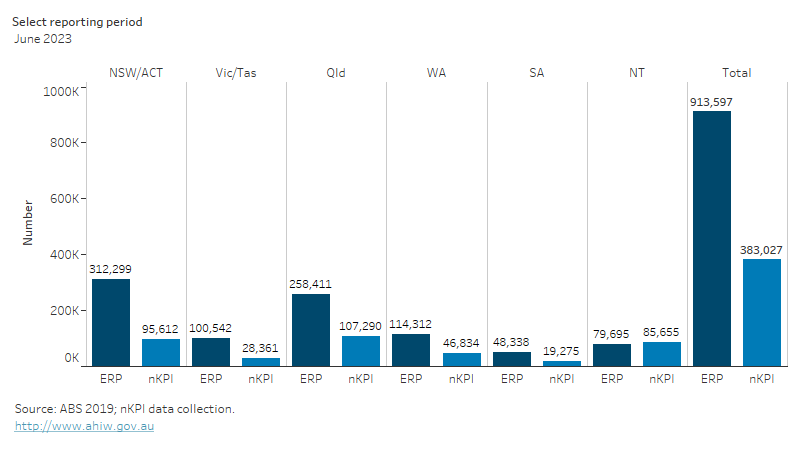nKPI – clients
There were over 383,000 First Nations regular clients at June 2023 (that is, First Nations clients who had visited the organisation 3 or more times in the 2 years up to 30 June 2023) (Figure 1). This is based on estimates provided by the organisations and may differ from the number of First Nations regular clients reported as indicator denominators (for more information see Data).
Figure 1: First Nations regular clients by reporting period
First Nations regular clients by reporting period
This Tableau visualisation shows the number of First Nations regular clients for either:
- type of organisation (ACCHO, non-ACCHO)
- remoteness area (Major cities, Inner regional, Outer regional, Remote, Very remote)
- state/territory (NSW/ACT, Vic, Qld, WA, SA, Tas, NT)
- age/sex (male, female, unknown with aged groups 0–4, 15–24, 25–34, 35–44, 45–54, 55–64, 65+).
Reporting periods of either June 2017, December 2017, June 2018, December 2018, June 2019, December 2019, June 2020, December 2020, June 2021, December 2021, June 2022, December 2022 or June 2023 can be selected.
Data supporting this visualisation are available in Excel supplementary data tables at Data.

Notes
- Data for ‘Age/sex’ are based on the number of First Nations regular clients collected as part of PI03 and PI09 and does not include ages 5–14 prior to December 2020. All other data are based on the number of First Nations regular clients with age and sex recorded and include all ages for all periods.
- For more information, including on interpreting changes over time, see Technical notes.
Of clients:
- 24% (or around 90,700) were seen in Major cities, 21% (81,100) in Inner regional areas, 20% (75,400) in Very remote areas, 19% (73,500) in Outer regional areas and 16% (62,400) in Remote areas
- 84% (or around 323,000) were seen in Aboriginal Community Controlled Health Organisations (ACCHOs), of which:
- 26% (or around 84,000) were seen in Major cities, 23% (74,600) in Inner regional areas, 22% (70,300) in Outer regional areas, 17% (53,800) in Remote areas and 13% (40,400) in Very remote areas
- 16% (or around 59,900) were seen in organisations other than Aboriginal Community Controlled Health Organisations (non-ACCHOs), of which:
- 58% (or around 35,000) were seen in Very remote areas, 14% (8,500) in Remote areas, 11% (6,700) in Major cities, 11% (6,500) in Inner regional areas and 5% (3,300) in Outer regional areas
- 54% (or around 202,600) were female
- 61% (or around 126,100) were aged under 35.
At June 2023, 42% of the estimated resident First Nations population (around 914,000) were First Nations regular clients of organisations reporting to the nKPI collection (around 383,000) (Figure 2).
Figure 2: First Nations regular clients compared with the estimated resident First Nations population by state/territory and reporting period
First Nations regular clients compared with the estimated resident First Nations population, by state/territory
This Tableau visualisation shows the number of First Nations regular clients compared with the estimated resident First Nations population (First Nations ERP) by state/territory (NSW/ACT, Vic, Qld, WA, SA, Tas, NT) for June 2023.
Data supporting this visualisation are available in Excel supplementary data tables at Data.

Notes
- In some cases clients may be counted at more than one organisation. The number of First Nations clients being greater than the First nations ERP is most common in Remote and Very remote areas.
- ERP is at 30 June of the relevant reporting period. Population projections for the period June 2017 to June 2023 are based on the 2016 Census of Population and Housing. The ERP may vary from that used for the OSR collection because of differences in reporting periods.
- Total is the sum of the states and territories and does not include external territories.
- nKPI data are based on data provided on the number of First Nations regular clients with age and sex recorded.
- ABS and nKPI data include all ages.
- For more information, including on interpreting changes over time, see Technical notes.
For more information on clients see Data.
Reference
ABS (Australian Bureau of Statistics) (2019) Estimates and Projections, Aboriginal and Torres Strait Islander Australians, 2006 to 2031 [Series B projections], ABS cat. no. 3238.0, ABS, Australian Government, accessed 1 November 2023.


